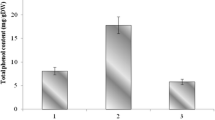Abstract
We carried out a systematic research on antioxidant activities of ethanolic extracts of aerial parts (stems and leaves) of four selected Stevia rebaudiana lines. Total phenolics and flavonoids contents of different S. rebaudiana lines were in the range of 55.64–58.35 mg (gallic acid) g−1 dw and 48.29–60.33 mg (rutin) g−1 dw, respectively. The contents of phenolics and flavonoids, and antioxidant capacities in the leaves of S. rebaudiana were twofold to fivefold significantly higher than that in stems of S. rebaudiana. SR-3 had the highest total phenolics and flavonoids contents and the strongest scavenging abilities to DPPH and ABTS radicals. DPPH and TEAC assays were equal to evaluate the antioxidant ability of ethanolic extract of S. rebaudiana. The obtained results clearly indicated that the leaves of S. rebaudiana had an important value of utilization and development as a natural antioxidant agent and further studies for SR-3 should be put into practice.




Similar content being viewed by others
References
Abou-Arab, E.A., and F.M. Abu-Salem. 2010. Evaluation of bioactive compounds of Stevia rebaudiana leaves and callus. African Journal of Food Science 4: 627–634.
Aehle, E., S.R.-L. Grandic, R. Ralainirina, S. Baltora-Rosset, F. Mesnard, C. Prouillet, J.-C. Mazière, and M.-A. Fliniaux. 2004. Development and evaluation of an enriched natural antioxidant preparation obtained from aqueous spinach (Spinacia oleracea) extracts by an adsorption procedure. Food Chemistry 86: 579–585.
Bruckdorfer, K.R. 2005. Oxidative stress. In Cardiovascular disease, diet, nutrition and emerging risk factors (The report of the British nutrition foundation task force), ed. Stanner, S., 78–98. Oxford: Blackwell Publishing.
del Baño, M.J., J. Lorente, J. Castillo, O. Benavente-García, J.A. del Río, A. Ortuño, K.-W. Quirin, and D. Gerard. 2003. Phenolic diterpenes, flavones, and rosmarinic acid distribution during the development of leaves, flowers, stems, and roots of Rosmarinus officinalis, antioxidant activity. Journal of Agricultural Food Chemistry 51: 4247–4253.
Heim, K.E., A.R. Tagliaferro, and D.J. Bobilya. 2002. Flavonoids antioxidants, chemistry, metabolism and structure-activity relationships. Journal of Nutrition Biochemistry 13: 572–584.
Jayaraman, S., M.S. Manoharan, and S. lllanchezian. 2008. In-vitro antimicrobial and antitumor activities of Stevia rebaudiana (Asteraceae) leaf extracts. Tropical Journal of Pharmaceutical Research 7: 1143–1149.
Kaushik, R., P. Narayanan, V. Vasudevan, G. Muthukumaran, and A. Usha. 2010. Nutrient composition of cultivated stevia leaves and the influence of polyphenols and plant pigments on sensory and antioxidant properties of leaf extracts. Journal of Food Science and Technology 47: 27–33.
Kim, I.-S., M. Yang, O.-H. Lee, and S.-N. Kang. 2011. The antioxidant activity and the bioactive compound content of Stevia rebaudiana water extracts. LWT-Food Science and Technology 44: 1328–1332.
Larson, R.A. 1988. The antioxidants of higher plants. Phytochemistry 27: 969–978.
Li, H., X.Y. Wang, Y. Li, P.H. Li, and H. Wang. 2009. Polyphenolic compounds and antioxidant properties of selected China wines. Food Chemistry 112: 454–460.
Madan, S., S. Ahmad, G.N. Singh, K. Kohli, Y. Kumar, R. Singh, and M. Garg. 2010. Stevia rebaudiana (Bert.) Bertoni-a review. Indian Journal of Natural Products Research 1: 267–286.
Pengelly, A. 2004. Polyphenolics-Tannins and Flavonoids. In The constituents of medicinal plants. 2nd edition, ed. Pengelly, A., 35. New South Wales: Allen & Unwin.
Pourmorad, F., S.J. Hosseinimehr, and N. Shahabimajd. 2006. Antioxidant activity, phenol and flavonoids contents of some selected Iranian medicinal plants. African Journal of Biotechnology 5: 1142–1145.
Prakash Chaturvedula, V.S., M. Upreti, and I. Prakash. 2011. Diterpene glycosides from Stevia rebaudiana. Molecules 16: 3552–3562.
Prior, R.L., X.L. Wu, and K. Schaich. 2005. Standardized methods for the determination of antioxidant capacity and phenolics in foods and dietary supplements. Journal of Agricultural Food Chemistry 53: 4290–4302.
Re, R., N. Pellegrini, A. Proteggente, A. Pannala, M. Yang, and C. Rive-Evans. 1999. Antioxidant activity applying an improved ABTS radical cation decolorization assay. Free Radical Biology Medicine 26: 1231–1237.
Sastre, J., A. Millan, J.G. de la Asuncion, R. Pla, G. Juan, F.V. Pallardo, E. O’Connor, J.A. Martin, M.-T. Droy-Lefaix, and J. Viña. 1998. A Ginkgo Biloba extract (EGb 761) prevents mitochondrial aging by protecting against oxidative stress. Free Radical Biology Medicine 24: 298–304.
Singh, S.D., and G.P. Rao. 2005. Stevia, the herbal sugar of 21st century. Sugar Tech 7: 17–24.
Tadhani, M.B., V.H. Patel, and R. Subhash. 2007. In vitro antioxidant activities of Stevia rebaudiana leaves and callus. Journal of Food Composition Analysis 20: 323–329.
Tavarini, S., M. Ribuoli, M. Bimbatti, and L.G. Angelini. 2010. Functional components from Stevia rebaudiana Bert. leaves. Journal of Biotechnology 150: 326.
Van Beek, T.A. 2002. Chemical analysis of Ginkgo biloba leaves and extracts. Journal of Chromatography A 967: 21–55.
Xi, Y., T. Yamaguchi, M. Sato, and M. Takeuchi. 1998. Antioxidant actitvity of Stevia rebaudiana. Nippon Shokuhin Kagaku Kogaku Kaishi 45: 310–316. (in Japanese).
Yang, W.T., W. Wu, Q.R. Cai, Y.W. Xu, and C. Wei. 2011. Comparison on main agronomic traits and glucoside content in different Stevia rebaudiana new lines. Sugar Crops of China 3: 26–29. (in Chinese).
Acknowledgments
The authors thank Miss Q. Liu for providing convenient experiment environment and equipments. We are also grateful to Dr. Y. W. Xu for giving pertinent suggestions in article’s peer view.
Author information
Authors and Affiliations
Corresponding author
Rights and permissions
About this article
Cite this article
Zeng, J., Cai, W., Yang, W. et al. Antioxidant Abilities, Phenolics and Flavonoids Contents in the Ethanolic Extracts of the Stems and Leaves of Different Stevia rebaudiana Bert Lines. Sugar Tech 15, 209–213 (2013). https://doi.org/10.1007/s12355-013-0210-4
Received:
Accepted:
Published:
Issue Date:
DOI: https://doi.org/10.1007/s12355-013-0210-4




